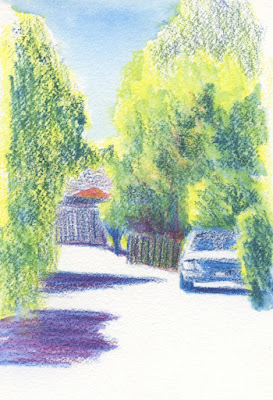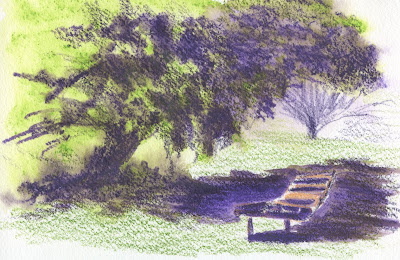 |
| 6/26/23 Maple Leaf alley |
When I showed the watercolor pencil sketch at left on social
media a few days ago, I was feeling frustrated with my ongoing direct watercolor practice. I quipped that I should start a “direct pencil”
challenge in which paints would not be allowed. Ha-ha.
I was kidding, but as usual, I started to think about it more than I should, and the question stayed on my mind: What would a “direct pencil” challenge look like? If we use the 30x30 Direct Watercolor challenge as a model, its purpose is to encourage daily practice, experimentation, making mistakes and learning from them. This is the part of Marc Holmes’ intention statement that engages me most:
“It’s an opportunity to deep-dive
into your own art-making process. Knowing you will return the next day, your
brain keeps thinking about art-making between sessions. Even while you sleep.
If you commit to the process, you’ll find your work changing quickly. You can
make sudden leaps in your technical ability, or discover new lines of inquiry.”
That principle is exactly the same as the one behind InkTober,
the 100-Day Project, Ian Roberts’ 30-day composition challenge
and other such challenges that encourage committing to a consistent creative
activity for a sustained length of time. That type of practice is known to push
people past whatever resistance they may have, and the result is often that
they make breakthroughs in their work. (I know it has worked for me more than once.)
As for the “direct” part – hitting the paper with the paint-filled brush without the guidance of a line drawing – Marc is not overly strict on that (he even admitted to using a line drawing on one of his complex paintings this month!). But I get why he encourages the “direct” approach: It’s a method most likely to result in a fresh, spontaneous expression, even at the expense of accuracy (and in the hands of a master like Marc and many others I’ve seen in the 30x30 Direct Watercolor Facebook group, that’s very much the case). Or, as he likes to put it, the direct approach allows watercolor to do what watercolor does best (without those of us clumsily wielding the brush to muck up watercolor with continual fiddling and trying to stay within whatever lines we may have drawn).
 |
| 6/27/23 Green Lake. This watercolor pencil sketch would have taken much longer without the value and intensity boost of water. |
With pencils (both graphite and colored) being my primary medium for the past several years, I’m not sure how I would challenge myself; I already use them nearly every day. Since many sketchers begin with a pencil when they first start out, it might not feel like much of a push for anyone.
One obvious challenge with pencil, however, is the same struggle I have with watercolor: It’s easy to be wimpy and difficult to be bold. Pale, weak watercolor washes are easy to make; strong, vivid colors are not. In the same way, a pencil sketch in which all the values look pretty much the same is easy to do. But using dry media to show a wide range of values is challenging and requires more effort. That’s one big reason why I favor watercolor pencils to dry colored pencils on location: It’s so much easier and more efficient to intensify colors quickly by applying water.
During the 30-day compositional challenge, I sometimes used graphite pencils to make studies, but even for small thumbnails, I often used markers because they were faster. Using dry pencils is more work, but certainly they are hard to beat for expressing a full range of values.
What if the challenge were to make a small, dry (colored or graphite) pencil drawing daily for 30 consecutive days with the specific goal of learning to see and develop values? I bet we would all get better at using dry pencils by the end of the challenge – and our values would have higher contrast, too.
I’m not ready to propose a challenge yet, but be warned: I’m still thinking about it.
I can hear your brain percolating this idea!
ReplyDelete